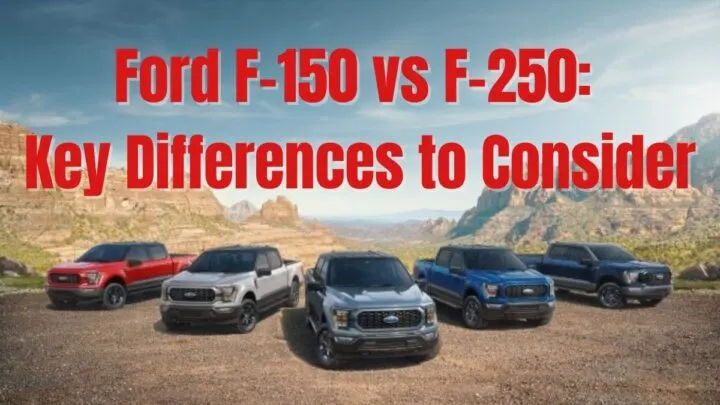Ford is renowned for making some best-in-class pickup trucks with outstanding reliability and power.
And when searching for a full-size workhorse truck, it can sometimes be challenging to differentiate between the F-150 and the F-250.
Even to seasoned truck owners, differentiating between the two can be pretty daunting.
Hence, in today’s article, we’re looking at key differences to consider when comparing the Ford F-150 and the F-250 and why one suits you better.
Engine Specs and Performance
One of the most crucial contrasts between the two trucks is their engine capacities and capabilities.
The F-250 is a medium-duty pickup truck from the Ford Super Duty line of trucks.
And, unlike the F-150, the F-250 trucks use heavy-duty chassis and frame components to allow for greater payloads and towing capabilities.
Therefore, they feature bigger engines, more robust drivetrains, but have poorer handling and maneuverability.
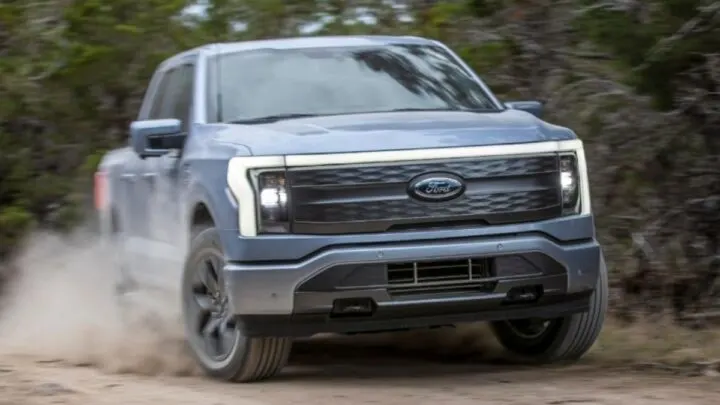
Ford F-150
The F-150 trucks come with smaller but diverse engine and drivetrain configurations than the Super Duty line of trucks.
Their engines have lower horsepower and torque ratings geared towards a balance in functionality, handling, and fuel efficiency.
Additionally, the F-150 has six engine options, including a hybrid, since it’s often used for more than just carrying and towing large workloads.
For example, the Ford F-150 XL comes with 3.3-liter Ti-VCT V6 engines that deliver 290 horsepower and 265 lb-ft of torque.
The engine is performance-oriented and features the Ford port-fuel and direct-injection (PFDI) system with dual injectors per cylinder.
The XL’s engine also comes paired with an electronic 10-speed automatic transmission, auto start-stop technology, and SelectShift automatic transmission with progressive range select.
Additionally, you’ll have an option to go with the following available engines.
Here’s a look at other Ford F-150 engines at your disposal.
- 2.7-liter EcoBoost V6 engine that delivers 325 horsepower and 400 lb-ft of torque.
- 3.5-liter EcoBoost V6 engine that delivers 400 horsepower and 500 lb-ft of torque.
- 5.0-liter Ti-VCT V8 engine that produces 400 horsepower and 410 lb-ft of torque.
- 3.5-liter PowerBoost Full Hybrid V6 engine that produces 430 horsepower and 570 lb-ft of torque.
- 3.0-liter Power Stroke V6 with 250 horsepower and 440 lb-ft of torque.
Since the light-duty F-150, by design, offers more services beyond towing and hauling loads, it has diverse engine configurations.
If you don’t need all the power of the F-150, go with the weaker 3.3-liter Ti-VCT engine that comes with the base models.
If you’re a serious off-roader, go with the more powerful 3.5-liter EcoBoost V6 engine with a best-in-class towing capacity of 14,000 pounds.
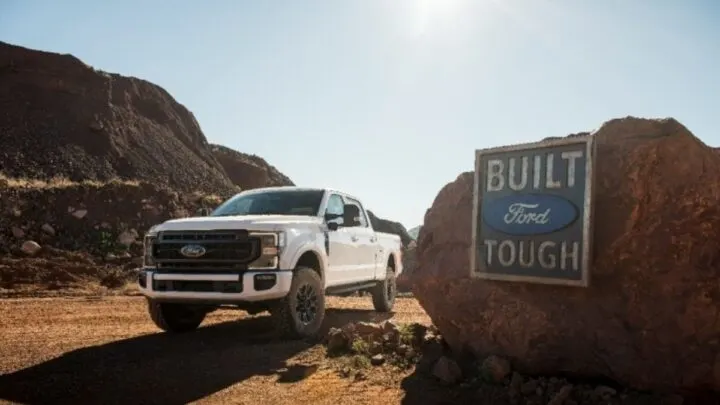
Ford F-250
The F-250 is a more robust truck that has just three engine configurations. Looking at the base Super Duty F-250 XL, the truck comes with a 6.2-liter SOHC 2-valve Flex Fuel V8 Gas engine that delivers 385 horsepower and 430 lb-ft of torque.
The engine is paired with the Ford TorqShift-G 6-speed transmission for better low-end torque.
And, if you need more power, you can go with the 7.3-liter 2V DEVCT NA PFI V8 engine rated at 430 horsepower and 475 lb-ft of torque.
The engine is robust for hauling heavy loads and performing strenuous duties and has commercial-grade durability, efficiency, and performance.
And if you’re not satisfied, then the mighty 6.7-liter Power Stroke V8 Turbo Diesel engine suits you.
It has a 36,000-psi fuel-injection system and delivers 475 horsepower and an impressive 1,050 lb-ft of torque.
As you can see, none of the F-150 engines comes even close to the torque available with the F-250 diesel engines.
Handling-wise, the F-250 is stiff and bouncy while unloaded or without the trailer, but gets smooth when loaded or with the trailer connected.
Towing and Payload Capacities
Both the F-150 and the F-250 are excellent options if you need to tow or carry heavy loads.
Looking closer, the F-150 is a more all-rounded truck with respectable payload and towing capacities that are less than those of the F-250 Super Duty trucks.
Ford F-150
As we’ve seen, the primary difference between the Ford F-150 and the F-250 is what they’re made to do.
The F-150 is a truck that offers a blend of highway driving and the ability to tow a sizeable load. As a result, it handles better, accelerates quicker, and is smoother than the F-250.
To unlock the impressive maximum towing capacity of 14,000 pounds, you’ll have to go with either the SuperCab or SuperCrew trims.
You’ll have to go with the 3.5-liter EcoBoost twin-turbocharged 400-horsepower, 2WD engine and the Max Trailer Package with both trims.
With this option, you’ll choose between a 3.55 or a 3.73 electronic locking rear differential, a seven-pin wiring harness, a 36-gallon gas tank, an upgraded rear bumper, and Pro Trailer Backup Assist.
Other features include:
- The smart trailer tow connector.
- Integrated trailer brake controller.
- A Class IV trailer hitch.
And, remember that the higher the trim level, the heavier your truck is. Therefore, the lower trims, such as the F-150 XL and XLT, have higher tow ratings.
Here are Ford F-150 maximum towing ratings per engine and drivetrain configurations.
- 3.5-liter EcoBoost V6 engine with 2WD – 14,000 pounds
- 3.5-liter EcoBoost V6 Full Hybrid engine with 2WD – 12,700 pounds
- 3.3-liter V6 engine with 2WD or 4WD – 8,200 pounds
- 5.0-liter V8 engine with 2WD or 4WD – 13,000 pounds
- 3.0-liter V6 engine with 4WD – 12,100 pounds
- 2.7-liter EcoBoost V6 engine with 4WD – 10,100 pounds
Additionally, the Ford F-150 has a maximum payload capacity of 3,325 pounds.
Ford F-250
The Ford F-250 has greater towing and payload capacities than its F-150 counterpart.
Depending on the powertrain and drivetrain configurations, it can tow between 12,300 pounds and 20,000 pounds.
For example, the F-250 tows up to 20,000 pounds and hauls up to 4,260 pounds of payload with the 6.7-liter Power Stroke V8 Turbo Diesel engine, Regular Cab, and Long Box configuration.
Furthermore, adding a fifth-wheel or gooseneck towing improves the truck’s towing capacity to a maximum of 22,800 pounds.
Additionally, the F-250 trucks have a varied payload of between 2,462 and 4,260 pounds.
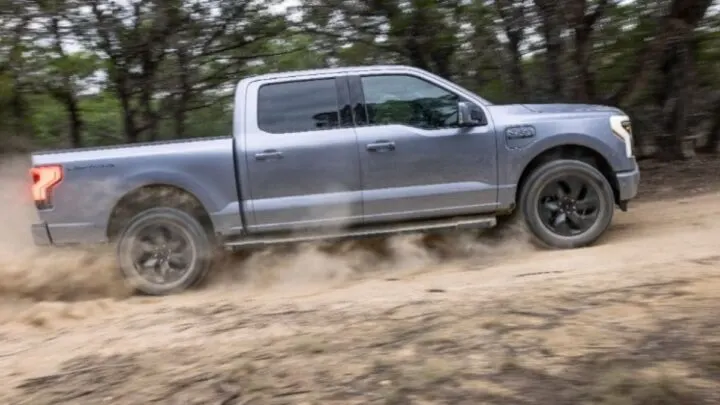
Manufacturer Suggested Retail Price (MSRP) Differences
The F-150 trucks are generally cheaper than similar trim level F-250 trucks.
Here’s a look at the Ford F-150 MSRP figures.
- XL – $30,870
- XLT – $38,515
- LARIAT – $48,450
- King Ranch – $59,670
- Platinum – $62,450
- Limited – $76,975
- Tremor – $53,470
- Raptor – $69,905
Here’s a look at the Ford F-250 MSRP figures.
- XL – $40,240
- XLT – $45,015
- LARIAT – $52,675
- King Ranch – $68,640
- Platinum – $71,955
- Limited – $90,675
Fuel Economy and MPG Ratings
The F-150 is a lighter truck and hence has better miles per gallon (MPG) ratings than the F-250.
As a result, it can be quite challenging for many people to decide between the two.
Should you sacrifice the towing and payload capacities for better fuel economy? Well, it depends on what you’re planning to do with your truck.
Here are the F-150 fuel economy figures according to the EPA.
- 3.5-liter V6 HEV with 2WD: 25 MPG city/ 26 MPG highway/ 25 MPG combined.
- 3.5-liter V6 HEV with 4WD: 24 MPG city/ 24 MPG highway/ 24 MPG combined.
- 3.0-liter V6 with 4WD: 20 MPG city/ 27 MPG highway/ 23 MPG combined.
- 2.7-liter V6 with 2WD: 20 MPG city/ 26 MPG highway/ 22 MPG combined.
- 3.3-liter V6 FFV with 4WD: 19 MPG city/ 22 MPG highway/ 20 MPG combined.
- 5.0-liter V8 FFV with 2WD: 17 MPG city/ 24 MPG highway/ 19 MPG combined.
Here are the F-250 fuel economy figures.
The EPA exempts heavy-duty and some medium-duty vehicles from its fuel economy tests.
Therefore, you won’t find any Ford Super Duty trucks’ fuel economy figures on their website.
From our tests, the F-250 averages 15 MPG on the highway and 14 MPG in stop-and-go city traffic.
Size and Curb Weight Differences
The Ford F-150 and F-250 Super Duty share a common cab structure, but significantly vary when you look at their exterior sizes.
For example, the F-150 wheelbase varies from 122.8 to 163.7 inches, whereas the F-250 wheelbase starts from 141.6 inches to 176 inches.
In terms of overall length, the F-150 tops out at 250.5 inches, while the longest F-250 is 266.2 inches.
Furthermore, the F-150 has a maximum cab height of 77.3 inches, compared to 81.5 inches for the F-250.
Weight-wise, the base F-150 weighs 4,021, whereas the top-end Crew Cab weighs 5,100 pounds.
Conversely, the F-250 weighs between 5,677 and 7,538 pounds, depending on the trim level and features.
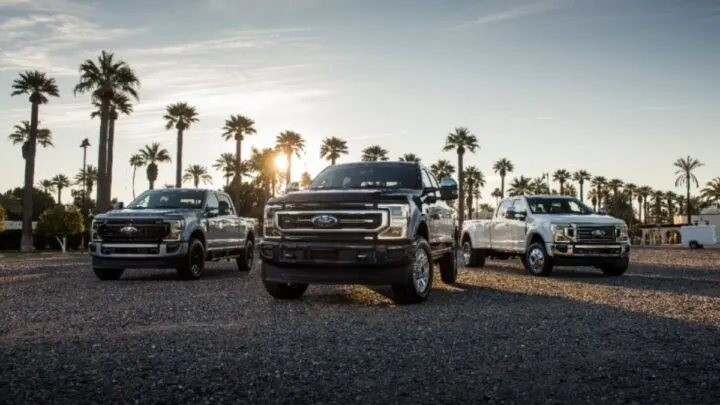
Final Remarks on the Ford F-150 vs. F-250
The F-250 is a workhorse primarily designed to haul heavy loads, whereas the F-150 is your everyday truck that can haul sizeable loads.
In other words, the F-150 has better handling, is smoother, more silent, and has better fuel economy figures than the F-250.
And personally, apart from the lesser towing capacity, the Ford F-150 is the more practical truck for everyday tasks.
